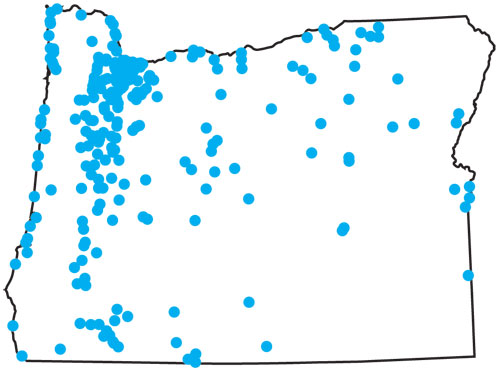 Oregon’s rural communities can’t afford the cheap, fast broadband service they need to compete. The problem gets a fresh spotlight as stimulus money is available.
Oregon’s rural communities can’t afford the cheap, fast broadband service they need to compete. The problem gets a fresh spotlight as stimulus money is available.
Oregon’s rural communities can’t afford the cheap, fast broadband service they need to compete. The problem gets a fresh spotlight as stimulus money is available.
BY ADRIANNE JEFFRIES
 |
ILLUSTRATION BY AMBER TAYLOR |
If you live in Portland, you probably take for granted the numerous options for affordable high-speed Internet — cable, DSL, satellite and even city-wide wireless, for as little as $30 a month.
But there are still pockets of Oregon where high-speed Internet is unavailable or prohibitively expensive. Access is limited in rural parts of the state where low population density discourages providers from building the expensive infrastructure needed to deliver high-speed, or broadband, Internet service.
But there is a new push from state and federal government to bring more broadband access to rural areas. The Oregon Public Utilities Commission received $2.1 million in federal grants in December to map and plan broadband access.
The bulk of recipients of the $7.2 billion appropriated to expand broadband access under the American Reinvestment and Recovery Act will be announced in March and some of the money could be coming to Oregon. Gov. Ted Kulongoski also recently appointed private and public sector representatives from urban and rural areas to the state’s new Broadband Advisory Council, which will make policy recommendations to the Legislature.
“There are parts of the service area where customers can get up to 20 Mbps [megabits per second] or even fiber to the home or business, but then there are also parts of the area where it’s just dial-up or satellite,” says Joe Franell, CEO of Eastern Oregon Telecom, which serves Umatilla County and parts of Morrow County. (Dial-up speeds are less than 1 Mbps; the Federal Communications Commission is looking at speeds of 2-4 Mbps as a floor for rural broadband access.)
 |
Oregon Cities with DSL and Cable Broadband AvailabilitySOURCE: BUSINESS OREGON |
Exact data on broadband access is incomplete. But a national USDA study says only 41% of adults in rural households had broadband access in 2008 as opposed to 55% of all U.S. adults. The same report shows that jobs grew faster in counties with early broadband access.
Consistent, affordable broadband has long been a challenge for businesses, governments, schools and citizens in Oregon’s rural areas, especially in Eastern Oregon. Counties have succeeded in getting DSL and wireless access to most residents in population centers, but speeds vary and ranchers and other rural households are often out of reach.
Lack of broadband access is extremely limiting when recruiting new businesses, and rural counties with low broadband access are often passed over, says Lisa Dawson, director of the Northeast Economic Development District. “You’re out of the running to begin with,” she says.
Service outages are also more common in rural areas, where service may depend on only one or two providers, and networks may not be “fully redundant,” with the extra connections that prevent network failures. Dawson remembers when the county’s primary Internet service provider cut out completely in Wallowa County in 2008. Many local businesses, especially retailers that needed to order inventory online, were disrupted for days until service was restored.
If a business, resident or local government in an unserved rural area wants broadband access, they usually have to pay to build a line. For a residential customer in an unserved rural area, access could cost hundreds of dollars a month.
Most of the access in the rural parts of the state is available because local governments scraped together the funds to build it themselves. Broadband is a high priority for rural schools, and in 2002 the Educational Service District in Wallowa County built a wireless T-1 network with speeds of 1.5 Mbps comparable to what a business with 20 to 50 employees might use. That network now provides Internet access to schools in Enterprise, Joseph and Wallowa cities, and the Wallowa Memorial Hospital in Enterprise. It used to take three days for the hospital to send X-rays to be read in Bend; now it takes an hour.
The pictures are still not ideal quality, so the hospital is building a fiber-optic network with speeds of 10 Mbps with a grant from Oregon Health Network, a not-for-profit that strives to improve health care by bringing low-cost, high-speed broadband to the state’s hospitals and clinics.
 |
SOURCE: BUSINESS OREGON |
Ubiquitous broadband access has been at least a nominal priority for Oregon since 1991, when then-Gov. Barbara Roberts organized a task force on telecommunications. “Oregon’s changing economy is becoming more information-intensive and our success in the Information Age depends on providing services that allow efficient access to and distribution of information,” the seven-member group wrote in a report called “Oregon’s Next Trail.” That sentiment persists today, when almost every business has a website and many use the Internet for research, communication and sales.
“In the state of Oregon, broadband is recognized as infrastructure right along with roads, bridges and water systems as being essential to support economic and business activity,” says Chris Tamarin, a telecommunications strategist at the state’s economic development department, Business Oregon.
Much of Oregon’s broadband access is credited to state legislation in 1999 that provided incentives for Qwest to spend $120 million on broadband infrastructure; it will likely take similar subsidies to get widespread access to the last few stragglers. Businesses and governments in Oregon have applied for more than $65 million in stimulus funding for broadband projects and most of the applications are for “last mile” unserved or underserved areas.
An application from the Canby Telephone Association, for example, proposes to build infrastructure in underserved areas of rural Clackamas County for farms, families and home-based businesses that now lack access to high-speed Internet. “This project is not simply a matter of enhanced quality of life, but to many it is a critical element of their economic security,” the application says.
Widespread broadband access is necessary to keep Oregon-based businesses competitive in the global marketplace, Franell says.
“Telephones and snail mail are dead forms of communication. Broadband access becomes critical to a state’s economy whether it’s agriculture or high tech or regular manufacturing or logging,” he says. “We need to make sure that all Oregonians have the opportunity to compete in the global market. If we do that, economically we’ll see a boost in Oregon. If not, we’ll be left behind.”


